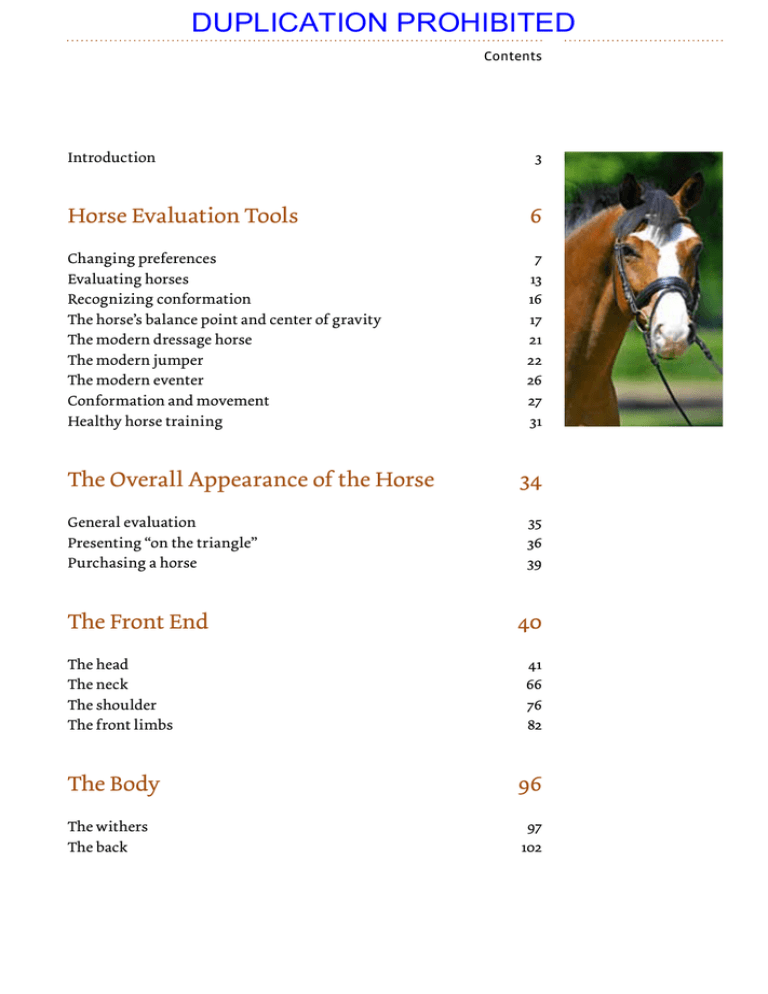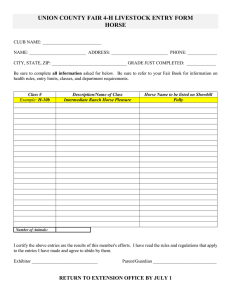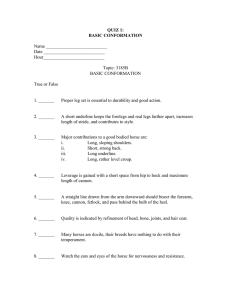duplication prohibited - Horse and Rider Books
advertisement

DUPLICATION PROHIBITED Contents Introduction3 Horse Evaluation Tools 6 Changing preferences Evaluating horses Recognizing conformation The horse’s balance point and center of gravity The modern dressage horse The modern jumper The modern eventer Conformation and movement Healthy horse training 7 13 16 17 21 22 26 27 31 The Overall Appearance of the Horse General evaluation Presenting “on the triangle” Purchasing a horse The Front End 34 35 36 39 40 The head The neck The shoulder The front limbs 41 66 76 82 The Body 96 The withers The back 97 102 DUPLICATION PROHIBITED Contents The Hind End The croup The hind limbs The hoof 112 113 118 125 Conclusion132 Index134 DUPLICATION PROHIBITED 16 Horse Evaluation Tools The lines and angles drawn on this horse’s body demonstrate an “ideal” conformation, though it is important to remember that, like this example, there is no such thing as a “perfect” horse. These are a few of the lines and geometrical figures used in my Equine Conformation System (ECS), which help to evaluate a horse’s conformation. (All are explained in detail throughout this book.) Recognizing conformation: the Equine Conformation System (ECS) I’m introducing this system to help you recognize a horse’s strengths and weaknesses by using geometrical factors—and to make these comprehensible. For example, let’s say you see a horse not performing well. Before you decide he is just not talented, consider the possibility that perhaps he is just being badly ridden and that he actually has a conformation that suggests movement potential or jumping talent. The ECS will help you assess the horse’s true potential. Deviations from these “ideal” lines, however, do not necessarily result in a flawed horse. Instead, they simply point toward areas that will need to be the focus of the horse’s future training. To the veterinarian, these deviations will indicate a risk of the horse being overstressed in these areas. DUPLICATION PROHIBITED The Horse’s Balance Point and Center of Gravity 17 Above all, this system will help to make individual body parts of the horse clearly recognizable. Horse evaluations that seemingly come from “the gut” and comments that reflect profound knowledge but are not able to be proved, are therefore a thing of the past! Clear lines and angles show parallels and proportions. They document the ideal and the minutest deviations and provide the evaluator with a foundation for his opinion. There is one thing, however, that these lines cannot do, and that is, describe a horse’s personality. This is a subjective impression reserved for those who want to understand the horse in his entirety. Remember, the ECS cannot measure temperament, character, willingness to work, and courage. The horse’s balance point and center of gravity According to the former German national eventing coach Max Habel, a good rider needs 1. Balance 2. Balance 3. Balance! And the Americans have added three additional factors: 1. Seat 2. Seat 3. Seat! These have one goal only: to find the equilibrium and keep it. A horse with a good education: appropriate muscling of the neck and an overall desired uphill position. DUPLICATION PROHIBITED 18 A flat croup like this one means the natural center of gravity is farther to the front of the horse, making it harder to train him to develop an uphill balance. Ideally, you want the horse’s center of gravity and the deepest point of the saddle (marked with an “x” in the photo), which is where the rider’s center of gravity sits, to be in the same spot. (For a good example, see the horse on p. 19.) A line drawn from the point of the hip to the thickest muscling in the neck demonstrates either an overall downhill tendency like this horse, or an uphill one like the horse on the opposite page. Horse Evaluation Tools X Center of Gravity The balance point Depending on his education, the horse’s point of balance moves on an imaginary line from the thickest point of the neck to the point of hip (see photos on pp. 18 and 19). The more a horse is educated and in an uphill balance (i.e. carrying himself with his hindquarters), the farther back this balance point will be. Ideally, this balance point aligns with the rider’s center of gravity, which is in the deepest point of the saddle. In the case of ideal conformation, this will also be the location of the horse’s center of gravity, as seen in the horse on the opposite page. Center of gravity The horse’s center of gravity is determined by evolution and the horse’s conformation and it cannot be altered through training. However it can be “shifted” under saddle (for example, compare the horse’s position in a rising trot on a loose rein to performing a levade). In order to find it, imagine two lines that serve to illustrate the horse’s natural center of gravity. The first line runs up from the point of shoulder over the spina scapulae (a palpable ridge on the scapula), the second from the hip joint over the point of hip (see photos on next page). A plumb line “dropped” down from the point where these two lines intersect indicates the horse’s center of gravity. It makes sense that a less steeply angled shoulder or a slightly sloped croup will place DUPLICATION PROHIBITED The Horse’s Balance Point and Center of Gravity the center of gravity more toward the horse’s rear, therefore making it easier for the rider to achieve the desired uphill tendency, while a steep shoulder or a flat croup will cause the opposite effect. Furthermore, the horse’s frame influences the position of his center of gravity. A compact horse with respective angulation of shoulder and croup will find it easier to “shift” his center of gravity than a horse with a longer body. Depending on the horse’s musculature and his phenotype, you can recognize whether it will be easy or hard to join the horse’s center of gravity with the rider’s. From the perspective of conformation evaluation, you want to look for a horse whose natural center of gravity is already located in the center of the saddle area, which makes it easier to align with your center of gravity since it is the goal of riding education to shift the horse’s center of gravity to under your own. With X Center of Gravity 19 Center of gravity The two white lines that intersect above the horse, indicating the horse’s center of gravity, tell you, at first glance, about the riding qualities of a horse and serve as the basis for further evaluation during his education. The conformation of this horse shows he possesses the desired balance with the tendency to easily lower his hind end. DUPLICATION PROHIBITED 20 Measuring height When obtaining the horse’s height with a measuring stick, measure from the ground to the highest point of the withers. When measuring with a tape, measure along the same line while the tape lies closely against the horse’s body. Consequently, the tape-measured height will be about four inches (10 centimeters) more than the stick measurement and therefore indicates a horse’s substance as well. Horse Evaluation Tools correct riding and a balanced seat this is achievable and with further education you can then create an “uphill” horse regardless of his skeletal conformation. (A horse that is “downhill” either through conformation or training, can never be in balance.) As a result of the “economical” design of a horse’s body, his natural center of gravity is located toward the forehand. This makes sense, since it enables the horse to simply follow his point of gravity during grazing without having to expend energy to overcome gravity time and again. There is no bony connection between body and forelimbs, a fact that further relieves the horse of skeleton stress here. The body is practically suspended between the front legs in a net of tendons, fascia, ligaments, and muscles. However, the lower leg is subjected to a high risk of excessive stress, especially when the rider’s weight is added to the horse’s own weight. Any deviation from the requirements laid out in the German Training Scale will ultimately put a strain on the horse’s balance and thus on his forehand and back. To sum up, the main goal of “relative elevation” is therefore to shift the horse’s center of gravity farther back to join up and “harmonize” with the rider’s center of gravity, which is in the deepest part of the saddle. When this happens, weight is taken off the forelimbs and the hindquarters take on the carrying function. The near horizontal line in the photos on the previous pages has its origin in the horse’s training and documents the “truth” in the following statement: “The rider forms the horse.” As mentioned, this line runs from the point of hip to the thickest point of the neck. When a horse is schooled according to the principles of classical dressage and has a neck similar to the shape of a stallion’s, this line points uphill (photo on p.19) . If, however, the horse has been constantly ridden against the hand, thus developing a thick lower neckline, this line points downhill (photo on p. 18). What makes this line interesting is that it proves a horse can be brought into the desired uphill tendency in spite of his anatomical prerequisites (angle of shoulder or flatness of croup) and that this horse does not have to be deprived of a solid education because of his conformational weaknesses.



